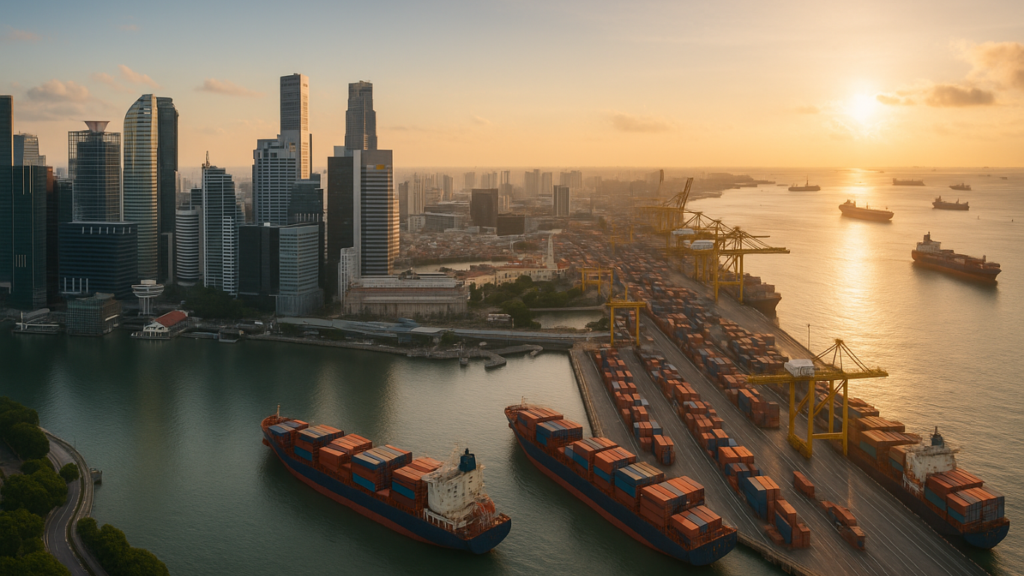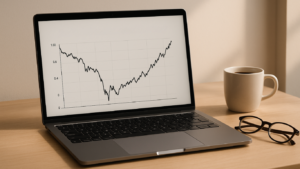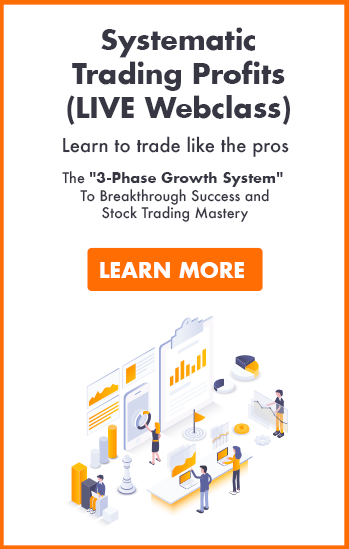Global trade impacts Singapore’s financial markets significantly. Two key metrics – trade-to-GDP ratios and market volatility – help explain this relationship. Singapore’s trade-to-GDP ratio often exceeds 300%, highlighting its reliance on global trade. While this openness can reduce exchange rate swings due to diversified trade flows, it also increases exposure to global disruptions. For traders, understanding these dynamics is critical for managing risks and seizing opportunities in Singapore’s highly interconnected economy.
Key takeaways:
- Trade-to-GDP ratio: Measures a country’s trade dependence; Singapore’s ratio is one of the highest globally.
- Market volatility: Reflects price fluctuations in financial markets, influenced by global trade shifts.
- Singapore’s position: High trade openness stabilises currency but heightens sensitivity to global crises.
- For traders: Use trade data to predict market trends, adjust positions, and manage risks effectively.
This article explores how these metrics impact Singapore’s markets and offers practical strategies for traders navigating this dynamic landscape.
Trade-to-GDP Ratios: Global Data and Singapore’s Position
The trade-to-GDP ratio is a key measure of economic openness, offering insights into how closely a country is tied to global markets. It highlights the extent to which external factors, such as global demand or supply chain disruptions, can affect domestic economic conditions. Singapore’s trade-to-GDP ratio, in particular, provides a fascinating lens through which to understand its role in the global economy.
How to Calculate Trade-to-GDP Ratios
The trade-to-GDP ratio is calculated by summing up a country’s total exports and imports, then dividing that figure by its gross domestic product (GDP). This result is expressed as a percentage.
For instance, let’s consider Singapore. If its total trade amounts to S$1.6 trillion and its GDP is S$500 billion, the trade-to-GDP ratio would be 320%. This figure underscores Singapore’s strong reliance on international trade, while also signalling its exposure to global economic shifts. Countries with higher ratios, like Singapore, are more vulnerable to changes in global markets, currency fluctuations, and supply chain issues. However, such openness also offers access to a broad range of markets and revenue opportunities, which can act as a cushion during domestic economic slowdowns.
Global Trade Openness Trends
Globally, trade-to-GDP ratios have been climbing steadily since the 1980s. Back in the 1970s, the global average hovered around 16%. Today, it has reached approximately 50–60%.
Different economies display varying levels of trade openness. For example, larger economies like the United States, with its vast domestic market, maintain relatively low ratios of around 25%. On the other hand, export-focused nations like Germany report ratios closer to 85%. However, recent global events, such as the COVID-19 pandemic and geopolitical tensions, have disrupted these trends. Between 2020 and 2022, many countries experienced a slowdown or even a decline in trade openness as supply chain vulnerabilities came to light. In response, some nations began rethinking their trade strategies. Meanwhile, many Asian economies doubled down on trade integration, particularly in manufacturing, technology exports, and services, reinforcing their global economic roles.
Singapore’s Global Trade Role
Singapore stands out as one of the most trade-dependent economies in the world, with a trade-to-GDP ratio that frequently exceeds 300%. In 2023, this ratio was around 320%, a reflection of Singapore’s unique position as a major re-export hub and logistics powerhouse. Its advanced port facilities and pro-trade policies have cemented its status as a global trade hub.
This high level of trade openness, however, comes with its challenges. Singapore’s economy is highly sensitive to global disruptions. For instance, during the COVID-19 pandemic, supply chain issues quickly transmitted external shocks to Singapore’s domestic market. The Straits Times Index, a key market indicator, experienced heightened volatility during this period, illustrating the direct impact of trade dependence on local markets. Yet, Singapore’s financial resilience – bolstered by the Monetary Authority of Singapore (MAS) and stringent financial regulations – helped mitigate these effects. Additionally, a diversified trade portfolio and proactive policy measures played a significant role in maintaining market stability.
Singapore’s openness to trade is both a strength and a challenge. While it benefits from global growth and access to diverse revenue sources, its economy remains highly sensitive to international developments. For investors and traders operating in Singapore’s financial markets, understanding these dynamics is crucial. Systematic strategies that account for external risks are especially important in such a volatile environment. Looking ahead, Singapore’s commitment to enhancing digital trade infrastructure, expanding free trade agreements, and strengthening logistics capabilities signals that its high trade-to-GDP ratio is here to stay.
How Trade Openness Affects Market Volatility
The link between trade openness and market volatility is more complex than it might seem at first glance. Singapore, with a trade-to-GDP ratio exceeding 300%, is deeply integrated into the global economy. Yet, its market stability is shaped by various factors beyond just trade volume.
Trade Openness and Exchange Rate Changes
Contrary to what some might expect, higher trade openness often reduces exchange rate volatility rather than increasing it. This happens because diversified trade flows help spread economic risks across multiple markets and currencies. For instance, research indicates that a 10% increase in bilateral trading relationships can reduce exchange rate volatility by 0.3%. In Singapore, the wide variety of trade transactions across different sectors helps shield the Singapore dollar (SGD) from isolated economic shocks.
This diversification acts as a safety net. If one trade channel faces disruption, others can step in to maintain balance. This is especially true for countries with fixed or intermediate exchange rate systems, which tend to experience lower exchange rate volatility even as they become more open to trade.
However, the extent of this stabilising effect hinges on trade diversification. Countries that rely heavily on a few trading partners or narrow sectors don’t enjoy the same level of protection. Singapore’s currency stability, despite its high trade openness, reflects deliberate efforts to diversify across industries, markets, and trading partners.
Next, let’s explore how these exchange rate dynamics influence equity markets.
Trade Openness and Stock Market Changes
The effects of trade openness extend beyond currencies to stock markets, creating a varied impact depending on trade composition and external dependencies. In Singapore, equity market volatility differs across sectors, influenced by their level of global integration.
Multinational corporations (MNCs) tend to experience lower volatility compared to domestic-only firms. Their global reach allows them to tap into larger markets and diversify revenue streams, acting as a buffer against local economic downturns. Evidence from German firms shows that exporters, especially in manufacturing, generally have more stable performance than non-exporters.
Similarly, MNCs listed on the Singapore Exchange that operate across multiple regions often face less volatility than companies focused solely on the domestic market. These firms benefit from the flexibility to shift operations across regions when one area encounters challenges, which translates to steadier stock performance.
Trade composition also plays a key role. Singapore’s focus on electronics and technology exports introduces sector-specific risks. Products like semiconductors and pharmaceuticals are more vulnerable to exchange rate changes, while commodity-based trade is influenced more by global price shifts. This means sectors like electronics may face heightened exposure to global demand and supply fluctuations, even as the broader market benefits from diversification.
Additionally, when industries with varying levels of global integration experience external shocks that aren’t perfectly correlated, overall market volatility can be reduced. Singapore’s diverse economy – spanning sectors like financial services, manufacturing, logistics, and technology – benefits from this effect, as disruptions in one sector may be offset by stability in another.
When Trade Openness Increases Volatility
Despite its stabilising potential, trade openness can sometimes amplify market volatility under specific conditions. Global trade disruptions, supply chain breakdowns, geopolitical tensions, and currency crises can quickly transmit shocks through highly open economies. The 2008 financial crisis highlighted how trade-dependent nations like Singapore can experience sharp swings in both exchange rates and equity markets during periods of global turmoil.
Supply chain vulnerabilities and reliance on specific trading partners are key risk factors. Even though Singapore has worked to diversify its trade relationships, certain sectors remain dependent on specific global supply chains or market conditions.
Currency fluctuations in major trading partners like China, the U.S., or the EU can also create spillover effects. The timing and nature of such external shocks matter greatly. While gradual changes in global trade patterns allow for adjustment, sudden disruptions can overwhelm the stabilising benefits of trade diversification.
For Singapore’s traders and investors, understanding these dynamics is essential. It helps them manage risk during periods of global uncertainty and integrate these insights into their trading strategies.
| Scenario | Exchange Rate Impact | Stock Market Impact | Risk Level |
|---|---|---|---|
| Diversified trade growth | Lower volatility | Stability in some sectors | Low |
| Concentrated trade dependence | Higher volatility | Increased sector risk | High |
| Global trade disruption | Sharp fluctuations | Broad market stress | Very High |
| Currency crisis in major partner | Spillover effects | Selective sector impact | Medium-High |
Master Systematic Trading with Collin Seow
Learn proven trading strategies, improve your market timing, and achieve financial success with our expert-led courses and resources.
Comparing Trade-to-GDP Ratios and Market Volatility
Looking at trade openness alongside market volatility reveals a mix of opportunities and challenges. Countries with varying levels of trade integration face unique hurdles and advantages when it comes to maintaining market stability.
High vs Low Trade-to-GDP Ratios: Benefits and Drawbacks
Choosing between high and low trade integration isn’t simple. Each comes with its own set of effects on market behaviour and economic adaptability.
| Trade-to-GDP Ratio | Benefits | Drawbacks |
|---|---|---|
| High | • Faster economic growth through access to global markets • Reduced exchange rate volatility due to diversified trade • Improved competitiveness and technology exchange • Broader opportunities for economic diversification |
• Greater vulnerability to global crises and external shocks • Increased sensitivity to commodity prices • Susceptibility to supply chain disruptions • Faster spread of international market volatility |
| Low | • Limited exposure to global economic shocks • Stronger resilience during international crises • More stable domestic market conditions • Shielded from external currency fluctuations |
• Slower economic growth potential • Higher exchange rate instability • Restricted access to foreign investment and technologies • Fewer chances for economic diversification |
Interestingly, research highlights that a 1% increase in the trade-to-GDP ratio above the median correlates with a 12% drop in bilateral real exchange rate volatility. This challenges the assumption that more trade automatically leads to heightened volatility. Instead, diversified trade ties can actually stabilise currency movements.
That said, high trade openness has its costs. Greater openness often brings increased market volatility, particularly in developing economies. The timing and nature of external shocks play a big role here. For instance, during the 2008 Global Financial Crisis and the COVID-19 pandemic, Singapore’s high trade-to-GDP ratio led to sharp GDP contractions and heightened market volatility. However, the same openness allowed for faster economic recoveries once global conditions improved.
These trade integration patterns provide a backdrop for Singapore’s unique economic landscape.
Singapore Market Examples
Singapore’s experience reflects the global dynamics of trade integration. With one of the world’s highest trade-to-GDP ratios, the country thrives as a global trading hub but also faces significant exposure to international economic shifts.
The Singapore dollar (SGD) is particularly sensitive to global events, a direct result of the country’s high trade openness. For example, during the pandemic, disruptions in global supply chains immediately impacted key sectors like manufacturing and logistics.
Singapore’s financial sector also highlights the dual nature of trade openness. DBS Group Holdings, Southeast Asia’s largest bank, benefits from Singapore’s role as a regional financial centre. However, its performance often mirrors global economic sentiment. During periods of uncertainty, DBS shares tend to show increased volatility as investors adjust their exposure to regional trade flows.
To manage these challenges, the Monetary Authority of Singapore (MAS) uses exchange rate policy as its main tool for maintaining economic stability. By actively managing the SGD’s trade-weighted exchange rate, MAS helps to curb excessive volatility, which in turn bolsters investor confidence.
Singapore also employs a mix of strategies to navigate market volatility. These include maintaining substantial foreign reserves, adopting prudent fiscal policies, and fostering a diverse economy. Additionally, the government’s focus on workforce upskilling ensures adaptability to global trends, while the country’s reserves act as a buffer against external shocks.
For traders based in Singapore, this high level of trade openness presents both opportunities and risks. Global market movements often have an immediate impact on local equities, requiring traders to stay attuned to international developments. Singapore’s ability to balance rapid economic growth with exposure to external shocks offers valuable insights for those operating in similarly open economies.
Trading Applications: Using Economic Data for Better Decisions
Understanding the relationship between trade-to-GDP ratios and market volatility can significantly improve market predictions and risk management. For traders in Singapore, where the economy is highly open and sensitive to external factors, leveraging these economic indicators can help navigate inherent market fluctuations.
Using Economic Indicators in Trading
Trade-to-GDP ratios act as a macroeconomic lens, helping traders anticipate periods of increased market volatility. Research highlights that a trading relationship 1% of GDP above the median reduces bilateral real exchange rate volatility by 12%. This makes trade-to-GDP ratios a valuable tool for gauging how vulnerable a country’s markets are to external shocks.
For traders in Singapore, keeping an eye on SGD exchange rate movements alongside trade data can provide early warning signals. A sharp change in non-oil domestic exports, for instance, often precedes volatility in the Straits Times Index (STI) and other local markets. A case in point is Q2 2020, when disruptions caused by COVID-19 led to a steep drop in Singapore’s exports, triggering significant swings in the STI. This example underscores how trade openness can amplify the impact of global events on local markets.
Beyond trade ratios, tracking GDP growth rates and sector-specific trade flows is equally critical. The timing of economic data releases also plays a major role, as markets often experience heightened volatility following GDP announcements. Traders who position themselves strategically ahead of such releases, using trade-to-GDP trends as a guide, can better anticipate market movements.
These insights form the foundation for systematic trading strategies designed to adapt during periods of high volatility.
Systematic Trading for Volatile Markets
Incorporating economic signals into systematic trading strategies can refine decision-making and risk management. In Singapore’s open economy, where external shocks can have a swift impact, systematic approaches rely on predefined rules and quantitative models to make objective trading decisions during turbulent times.
Collin Seow’s trading framework focuses on three essential questions: what to buy, when to buy, and how much to buy.
For timing decisions, traders can combine technical analysis with economic indicators and market trends. Educational resources like the Market Timing 101 E-Course from Collin Seow Trading Academy offer practical strategies for precise timing, which can be particularly useful when trade data signals potential market volatility.
Position sizing becomes a crucial consideration when trade-to-GDP ratios indicate heightened risk. By aligning position sizes with individual risk tolerance and risk-reward profiles, traders can manage exposure during uncertain periods. For instance, systematic traders might adjust leverage or tighten stop-loss levels when Singapore’s trade-to-GDP ratio spikes, preparing for potential market swings.
Risk Management for Singapore Traders
Given Singapore’s high exposure to global trade, effective risk management is indispensable. Increased trade openness often leads to higher volatility, making stop-loss orders an essential tool. For instance, as trade intensity rises, doubling real exchange rate volatility can reduce exports of differentiated products by 2%. Adjusting stop-loss levels based on trade data can help shield portfolios from sudden shocks.
Position sizing should also reflect current trade conditions. During the COVID-19 pandemic, for example, Singapore’s high trade integration led to sharp market contractions, highlighting the importance of scaling positions based on global trade trends. Diversifying portfolios becomes even more critical in open economies, where exposure to global trade shocks can vary significantly across sectors. Monitoring key economic releases – such as trade data and monetary policy updates – can help traders adjust their exposure to the most affected areas.
Currency hedging is another vital strategy for managing Singapore’s trade-related risks. Using SGD-denominated assets and hedging against exchange rate fluctuations can mitigate the volatility associated with high trade-to-GDP ratios. With the typical real exchange rate showing a standard deviation of about 11% from its trend, effective currency management is non-negotiable.
During periods of rising trade-to-GDP ratios or global uncertainty, traders should regularly review risk limits and reduce exposure to cyclical or export-dependent sectors. Educational resources from Collin Seow Trading Academy, including systematic trading courses and live webinars, can provide valuable insights into maintaining discipline and adapting strategies to Singapore’s trade-driven market dynamics.
Conclusion: Main Points to Remember
Key Findings Summary
The link between trade-to-GDP ratios and market volatility presents an intriguing paradox that every trader should grasp. Higher trade openness tends to reduce exchange rate volatility between trading partners. Research highlights that when a trading relationship is 1% of GDP above the median, it can lower bilateral real exchange rate volatility by 12%. This finding is particularly valuable for traders navigating highly interconnected markets.
Singapore offers a prime example of this phenomenon. With a trade-to-GDP ratio exceeding 300%, far surpassing the global average, the nation illustrates how extreme trade openness can stabilise certain market behaviours. Strong trading relationships with major economies like China and the US contribute to the relative stability of the Singapore dollar, even as the economy remains exposed to external shocks.
That said, high trade-to-GDP ratios also come with increased vulnerability to global economic disruptions. For instance, during the 2008 global financial crisis, Singapore’s heavy reliance on trade amplified the effects of plummeting global demand, resulting in sharp GDP declines and heightened stock market volatility. This dual nature of openness means that traders must balance their appreciation for the stability it can offer with an understanding of its risks.
Singapore’s distinctive position as a highly open economy makes these findings highly relevant for crafting local trading strategies. These insights can help traders refine their approach to navigating Singapore’s dynamic market landscape.
Next Steps for Traders
Armed with these insights, traders can take actionable steps to enhance their strategies. Success in trading often hinges on informed decision-making, and these findings provide a solid foundation for building a more strategic approach.
Start by closely monitoring trade data, such as non-oil domestic exports and bilateral trade flows, to anticipate potential market movements. Combining this macroeconomic awareness with systematic trading methods can strengthen your decision-making framework.
For traders seeking to refine their skills, Collin Seow Trading Academy offers tailored resources designed for Singapore’s trading environment. These include systematic strategies addressing the key questions of what to buy, when to buy, and how much to buy. Free e-courses and live webinars are available to help traders stay updated with real-time market strategies.
Additionally, focus on developing strong risk management practices suited to Singapore’s open economy. This involves adjusting position sizes based on trade-related volatility, employing currency hedging techniques, and diversifying investments across sectors with varying trade sensitivities. By combining economic insights with disciplined execution, traders can build a resilient foundation for long-term success in Singapore’s ever-evolving market.
FAQs
How does Singapore’s high trade-to-GDP ratio impact its exposure to global economic fluctuations?
Singapore’s high trade-to-GDP ratio highlights its strong connection to the global economy. This deep integration opens the door to growth and diversification but also exposes the nation to certain risks. External challenges like global recessions, supply chain issues, or geopolitical tensions can ripple through the economy.
For example, shifts in export demand or changes in international trade policies can significantly influence Singapore’s economic performance. This makes it crucial for the country to have a flexible and robust economic framework that can handle global uncertainties with confidence.
How can traders in Singapore use trade-to-GDP ratios to predict market volatility?
Trade-to-GDP ratios serve as a useful gauge of how much a country is engaged with the global economy. For traders in Singapore, keeping an eye on changes in these ratios can reveal potential shifts in market dynamics. When the trade-to-GDP ratio climbs, it often points to greater exposure to global economic swings. On the other hand, a dip in the ratio might suggest reduced trade activity and a lower susceptibility to external economic shocks.
By tracking these patterns, traders can better predict how changes in trade policies, global demand, or currency fluctuations might affect market conditions. Pairing this understanding with well-structured trading strategies can lead to more calculated and confident decisions. If you’re keen to sharpen your trading expertise, platforms like Collin Seow Trading Academy provide tools and resources to develop data-driven strategies for managing market volatility.
How does greater trade openness help reduce exchange rate volatility, and what does this mean for Singapore?
Countries with higher trade openness often experience less exchange rate volatility. Why? Steady trade flows create a consistent demand for foreign exchange, helping to smooth out currency fluctuations. This predictability benefits both businesses and economies by reducing uncertainty.
In Singapore, where trade is a cornerstone of the economy, this principle holds significant importance. Exports and imports account for a large share of the nation’s GDP, making a stable exchange rate essential for business operations and investor confidence. A dependable Singapore dollar (SGD) not only supports local businesses but also reinforces Singapore’s reputation as a leading global financial centre.












